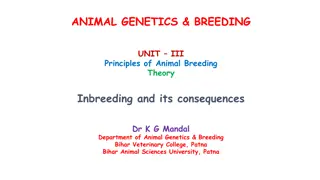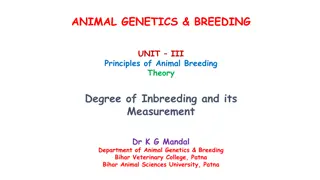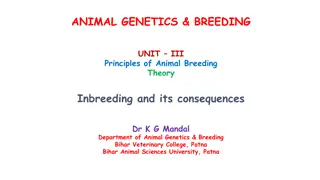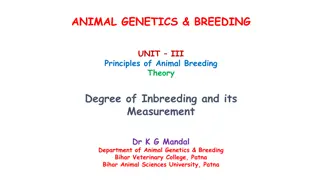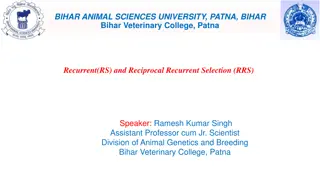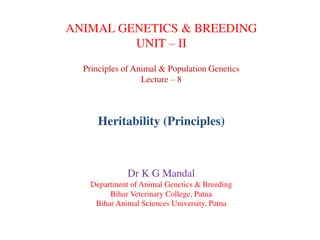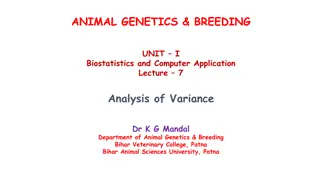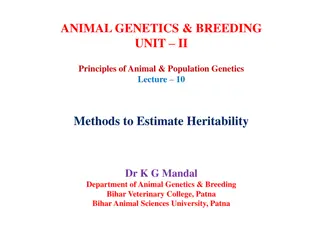Understanding Quantitative Genetics Principles in Animal Breeding
Quantitative genetics focuses on the inheritance of characteristics based on degree rather than kind, compared to qualitative genetics. It involves polygenes controlling quantitative traits, which exhibit continuous variation and can be measured using metric units. Qualitative traits, on the other hand, are controlled by a small number of genes and show discontinuous variation. The analysis of quantitative traits involves statistical tools like mean, variance, and correlation, while qualitative traits are analyzed through chi-square tests. Understanding the distinctions between quantitative and qualitative genetics is essential in animal breeding and population genetics studies.
Download Presentation

Please find below an Image/Link to download the presentation.
The content on the website is provided AS IS for your information and personal use only. It may not be sold, licensed, or shared on other websites without obtaining consent from the author. Download presentation by click this link. If you encounter any issues during the download, it is possible that the publisher has removed the file from their server.
E N D
Presentation Transcript
ANIMAL GENETICS & BREEDING UNIT II Principles of Animal & Population Genetics Lecture 5 Quantitative Genetics: Values & Means Dr K G Mandal Department of Animal Genetics & Breeding Bihar Veterinary College, Patna Bihar Animal Sciences University, Patna
Qualitative vs. Quantitative Genetics 1. Quantitative Genetics is the inheritance of those differences individuals which are of degree rather than kind, rather than qualitative. 1. Qualitative Genetics is the study of inheritance of those which are qualitative in nature. study of characters between quantitative 2. Qualitative characters follow discontinuous variation 2. Quantitative characters follow variation. continuous
3. Inheritance of quantitative characters is controlled by a large number of genes called polygenes, hence character polygenic traits. 3. Inheritance of qualitative characters is controlled by one, two or a very few number of genes. are called 4. Effect of individual gene is so prominent that its presence can be visible in the trait, for which those genes are called major gene. 4. Effect of individual gene is very small appreciable. effect of all the genes exhibits in the character, for which the polygenes are also called minor genes. and cumulative not
5. Quantitative traits can be measured/quantified through metric units (Kg., g., ml, mm, cm, ltr, etc.) for which they are also known as quantitative traits/biometric traits. 5. Qualitative traits can not be measured. 6. Qualitative traits can be analysed square test only. 6. Quantitative traits are analysed through statistical tools, like mean, variance, SD, SE, correlation, ANOVA etc. through chi- regression,
7. Classical medallion phenotypic can not be seen. 7. The classical mendelian phenotypic ratios can be seen groups due to effect of a single difference at a given locus. 8. Does not influence by environment. ratios between gene 8. Influenced through the effect environment. of
Qualitative vs Quantitative Genetics Measurement of characters : Non-Biometric / Biometric. No. of genes involved : One or Two / Polygene Effect of genes : Major / Minor Types of variation : Discontinuous / continuous Distribution : Binominal/ Normal Causes of variation : Genetic /genetic & environment Method of analysis : Chi-square/Mean, variance and covariance, Correlation,regression
Values and Means Introduction The objective of the study of population genetics is trait specific : - Qualitative traits - Quantitative traits The genetic variation for qualitative traits has been studied with the arrays of gene frequencies and genotype frequencies. In quantitative traits it cannot be studied with the arrays of gene frequencies and genotype frequencies since it is not possible to know that how many number of gene loci affecting a metric trait.
The mode of inheritance of quantitative traits in a population is the subject of quantitative genetics. Quantitative genetics is the study of inheritance of those differences between individuals that are of degree rather than kind, quantitative rather than qualitative. The properties of a population in connection with the metric characters are means, variances and covariances. These are called as observable properties of a population for a metric trait. The mean, variance and covariance are influenced by the genetic properties i.e., gene action ( additive, dominance and epistasis), linkage, pleiotropy and fitness of genes under natural selection.
Phenotypic Value The value observed when a character is measured on an individual in metric units i.e., g, kg, lb, mm, cm, days, etc. Thus the value observed on an individual due to measurement of a trait is called phenotypic value of that individual. All the observed properties whether mean, variance or covariance measurement of phenotypic values. are based on
Components of Phenotypic Value Genotypic Value & Environmental Deviation In order to analyse the genetic properties of the population, the phenotypic value has to be divided into components attributable to different causes. Phenotype is the expression of genotype at the cost of environment. Thus, the phenotypic value has to be divided into components attributable to the influence of genotype and environment. The genetic constitution of an individual is known as genotype. The value of the character attributable to the effect of genes is called genotypic value. All the non-genetic factors that influence the phenotypic value of an individual are called environment.
The environment modifies the effect of genotypic value before the character is finally expressed in the form of phenotypic value. The effect of environment that causes the deviation in genotypic value is termed as environmental deviation. The genotype gives rise to a certain value to the character, and environment changes this value in either direction before the character is expressed by the individual. Thus, there are two components of phenotypic value, the value assumed by the genotype is called genotypic value and the deviation caused by the environment is called as environmental deviation.
Accordingly, P = G + E Where, P = Phenotypic value G = Genotypic value E = Environmental deviation in genotypic value. The individuals of a population are exposed to different environmental conditions. The good environment favours the genotype while poor environment does not favour the full expression of the genotypic value. As such the phenotypic value is expected to be better under favourable environment and poor under poor environmental condition. Therefore, the environmental effects are cancelled out in taking average of phenotypic values of all the individuals exposed to different environmental effects, and the mean environmental deviation in the population as a whole is zero ( E = 0).
Therefore, the environmental deviation do not contribute to the population mean. This results the mean phenotypic value equal to the mean genotypic value. Genotype Environment Interaction Different genotypes may respond differently to different environments. This results in different mean phenotypic value for different genotypes under different environments. This differential response of different genotypes under different environments is called genotype environment interaction. It is denoted as IGE. Under such condition, the phenotypic value , P = G + E + IGE
Values Assigned to the Genotypes For the purpose of deduction of mean phenotypic value, the different genotypes are assigned with arbitrary genotypic value. Genotype Genotypic value A1A1 +a A1A2 d A2A2 - a Hence, the scale of genotypic values will be as follows : A2A2 -a 0 Suppose A1 allele increases the value. The origin or point of zero on this scale is the mid-value between the values of two homozygotes. A1A2 d A1A1 +a
In heterozygote, the value of d depends on the degree of dominance. If there is no dominance, d = 0; If A1 is dominant over A2, d is positive; If A2 is dominant over A1, d is negative; If dominance is complete, d is equal to +a or -a If there is overdominance, d > + a or < -a; The degree of dominance may be expressed as d/a.
Example: Inheritance of dwarfing gene, known as pygmy gene (pg) in mouse. This gene reduces the body weight. The body weights of different genotypes of mouse at 6-weeks of age are as follows: Genotypes ____________________________________ ++ +pg ____________________________________ Body weight (g) 14 12 __________________________________________ 14 12 Values taken as deviation from population mid-value ___________________________________________ + 4 2 pgpg 6 10 6 0 - 4
Population Mean Consider a locus with two alleles A1 & A2 with respective frequencies as p and q Genotype Frequency Genotypic Value a d -a Sum = ap2 + 2pqd aq2 = ap2 aq2 +2pqd = a(p2 q2) + 2pqd = a(p+q)(p-q) +2pqd = a(p- q) + 2pqd Freq x Value ap2 2pqd -aq2 A1A1 A1A2 A2A2 p2 2pq q2
For a single locus M = a(p - q) + 2pqd Where, M = population mean a = assigned genotype value of homozygotes. d = degree of dominance assigned to heterozygote. if d = 0, then M = a (1 2q) if d = a, then M = a (1 2q2) if A1 is fixed (p = 1), then M = a if A2 is fixed (q = 1), then M = -a
Since, quantitative traits are influenced by the genes situated at many loci then, M = a(p q) + 2 pqd. If all the genes that increase the value are fixed, then population mean, M = a(p q) + 2 pqd M = a(1 0) + 2 1x0xd. = + a and vice versa , (M = - a).
Genotypic value It is measured as a deviation from the population mean Genotype Assigned Values a GV deviated from population mean a M= a [a(p q) + 2pqd] = 2q ( a pd) d M = d [a(p q) + 2pqd] = a (q p) + d (1 2pq) -a M = -a [a(p q) + 2pqd] = -2p (a +qd) A1A1 A1A2 d A2A2 -a Mean genotypic value = 0 (zero)
Genotypic value of A1A1 = a [a(p q) + 2pqd] = a(1 p +q) 2pqd = a(p + q p +q) 2pqd = a(2q) 2pqd = 2q(a pd) Genotypic value of A2A2 = -a - [a(p q) + 2pqd] = -a(1 + p q) - 2pqd = -a(p + q + p q) - 2pqd = -a(2p) - 2pqd = - 2p(a + qd)
Mean Genotypic Value Since the genotypic values are taken as deviation from the population mean, the mean genotypic value of the population would be zero. The mean genotypic value = sum of product between genotypic value and frequency of respective genotypes. Thus, mean genotypic value = p2[2q(a pd)] + 2pq[a(q p) + d(1 2pq] + q2[ - 2p(a + qd)] = 2p2q(a pd) + 2pqa(q p) + 2pqd 4p2q2d 2pq2a 2pq3d = 2p2qa 2p3qd + 2pq2a 2p2qa + 2pqd 4p2q2d 2pq2a - 2pq3d = 2p3qd + 2pqd 4p2q2d 2pq3d = - 2pqd[p2 1 + 2pq + q2] = -2pqd[ p2 + 2pq +q2 1] = -2pqd[1 1] = 0




